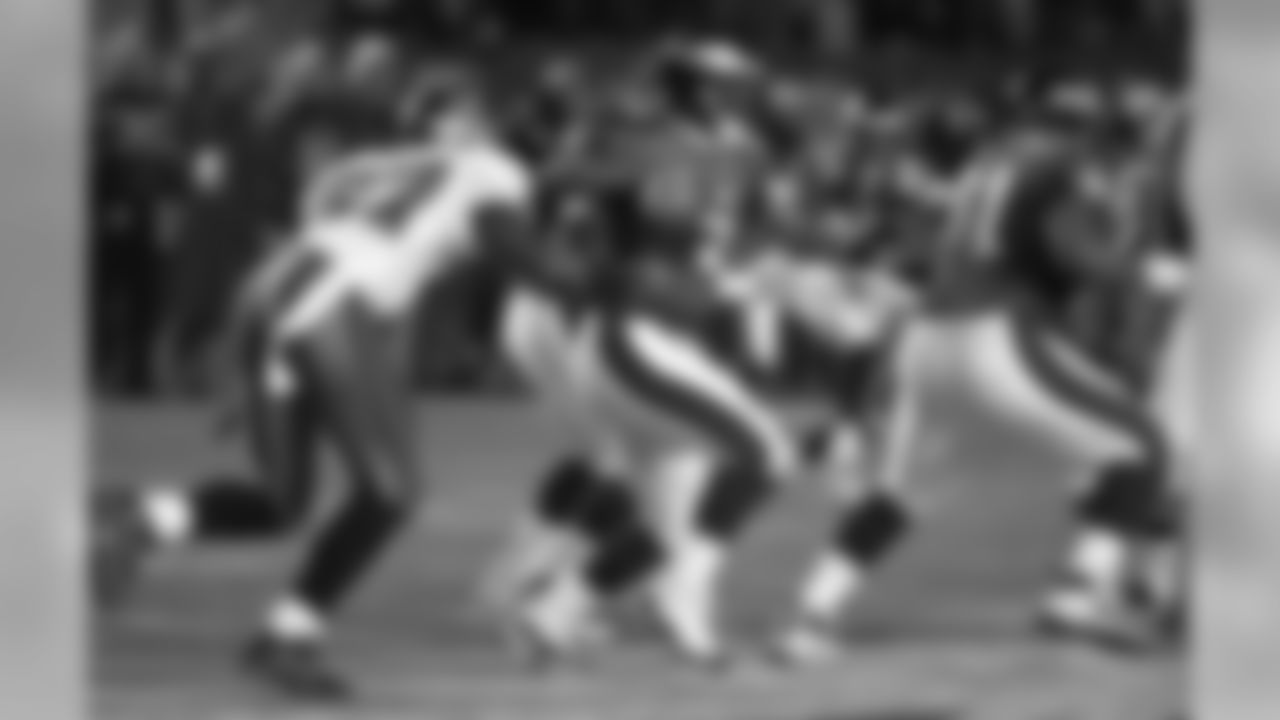Photos of Buccaneers vs. Eagles matchups through the years.

















On Sunday, the 4-5 Tampa Bay Buccaneers take on the 4-5 Philadelphia Eagles at Lincoln Financial Field. It will be the 14th meeting between the two teams in the regular season but Tampa Bay's first trip to Philadelphia since 2009. Both teams will be trying to get back to .500 and stay close in the crowded NFC playoff race.
To get their first win in Philly since a memorable pair of games in the 2003 calendar year, the Buccaneers will have to keep from being overwhelmed by the Eagles' fast-paced attack while also avoiding the turnovers that are Philadelphia's defensive calling card. Here's a closer look at the challenges the Buccaneers will face on Sunday when they visit the Eagles' home.
HEAD COACH

Even though Chip Kelly is in just his third season in the NFL in any capacity, he's quickly became one of the league's highest-profile head coaches. Much of that is based on the up-tempo offense he has brought in from his days at Oregon, but Kelly also made news this past offseason with a very aggressive approach to reshaping the Eagles' roster. Most importantly, Kelly's Philadelphia teams were winners right from the beginning; the Eagles are 24-17 in his two-and-a-half seasons at the helm so far.
In fact, the Eagles won the NFC East with a 10-6 record in Kelly's debut season in 2013, largely on the strength of an attacking offense that set an NFL record with 99 plays of 20 or more yards. Philadelphia went 10-6 again last year, though that proved to be one win shy of a playoff berth. This year, the Eagles are 4-5 but have won three of their last five and just barely missed making it four of five with a one-point loss to Miami last Sunday.
Kelly coached for 23 seasons on the collegiate level, beginning at Columbia in 1990 and advancing through New Hampshire (his alma mater), Johns Hopkins and Oregon. He won several national Coach of the Year awards along the way and is described in his Eagles bio as a "football junkie" with a "matter-of-fact leadership style." His spread offense is obviously his calling card; in his four years at the helm in Oregon (after two as the offensive coordinator), the Ducks averaged 44.7 points per game.
During those four years, Kelly compiled a 46-7 as the head coach and led the Ducks to four BCS bowl appearances. In 2012, Kelly's last year on a collegiate sideline, Oregon ran 1,077 plays in 13 games, which was more than all but six NFL teams did in 16 games in 2012. The Eagles named Kelly their head coach on January 16, 2013. In his first two seasons, Philadelphia broke its single-season team scoring record twice, with 442 in 2013 and 474 last year. This year's Eagles haven't set quite the same pace – their 212 points through nine games projects to 376 by season's end – but Kelly has still done an excellent job of installing big-playmakers on both sides of the ball.
OFFENSE

Kelly reworked the Eagles' offensive backfield in the offseason, trading Nick Foles for Sam Bradford at quarterback and replacing LeSean McCoy (traded to Buffalo) with DeMarco Murray (signed from Dallas) as the lead rusher. Philly's offensive approach hasn't changed, however, and it's well-represented in this pair of stats: Despite being tied for last in the league in producing drives that last five minutes or more, the Eagles are tied for eighth in drives that last 10 plays or more.
Philadelphia's offense is last in the league in average time of possession (26:52), but that was true in both 2013 and 2014, as well, and it didn't stop the Eagles from ranking fourth and third in scoring in those two years, respectively. Their quick-strike approach has produced tons of big plays, the most plays of 20 or more yards (216) in the NFL since Kelly arrived. The Eagles are down just a bit in that category in 2015, though still ranked fifth with 42 20+-yard plays, compared to the league average of 37. Interestingly, it's in the running game where Philly pulls away from the pack in that regard, as they are very near league-average in big passing play but fourth in runs of 20 or more yards.
Bradford has used Kelly's system to put up a career-high 63.9% completion percentage, ninth-best in the NFL, and he's shown he can put up big numbers with a pair of 330+-yard performances. His season has experienced its share of ups and downs, however, which is reflected in a nearly even 11-10 TD-INT ratio. Bradford has finished three games with a passer rating of 103 or better but also finished three with a rating of 66 or worse. It's potentially a moot point for the Buccaneers, since the Eagles' starter sustained a concussion and a left (non-throwing) shoulder injury in last Sunday's game. Philly's second-string passer is the experienced Mark Sanchez, who had his own ups and downs in eight starts for the Eagles last year but did throw 14 TD passes and rack up about 300 yards per game. Sanchez has historically been a bit more mobile than Bradford, with 433 rushing yards and 13 touchdowns to 278 and two for Bradford.
Murray, on the other hand, has just started to hit his groove after a painfully slow start in Philadelphia. The NFL's rushing yardage (1,845) and yards from scrimmage (2,261) leader as a Cowboy in 2014, Murray had just 47 yards on his first 29 carries as an Eagle, a span that covered three games plus another contest missed due to a hamstring injury. Over the last four weeks, however, Murray is tied for ninth in the NFL with 476 yards from scrimmage, averaging 119 per outing. He's getting it done both on the ground and through the air, particularly over the last two weeks, during which he's caught 12 passes for 136 yards.
The Eagles actually signed both Murray and former Charger Ryan Matthews after trading McCoy, and the two backs have complemented each other well. Matthews has 75 carries to 128 for Murray but is averaging 5.69 per tote, second in the NFL among qualifiers to Buffalo's Karlos Williams. Darren Sproles is a pass-catching third-down back but he hasn't been a significant part of the offense in the last month, with 117 yards on 26 touches over four games.
All those backs run behind an offensive line anchored by left tackle Jason Peters, a seven-time Pro Bowler and a first-team Associated Press All-Pro choice last year. The 6-4, 328-pound Peters is a powerful run-blocker but surprisingly nimble for his size, making him a huge asset in pass protection, too. However, Peters has missed the Eagles' last two games with a back injury, with the team sliding former first-round pick Lane Johnson over from the right edge to fill that spot. Jason Kelce has been a fixture at center for the Eagles since 2011 but the guard are largely unproven. LG Allen Barbre had started eight games for three teams over seven years before 2015 and RG Matt Tobin was a 2013 undrafted pick-up who started his first seven games last year. According to Football Outsiders, the Eagles' have had the 30th-best run-blocking front and the 16th-best pass-blocking line this year. It would be better with Peters on the field; according to Pro Football Focus, he has allowed just six QB pressures all year.
With DeSean Jackson and Jeremy Maclin leaving town over the past two years, the Eagles have turned over their receiving corps as well, and the leading pass-catcher is now 2014 second-round pick Jordan Matthews. Matthews is tied for 13th in the NFL with 51 receptions, though he averages a modest 10.8 yards per catch. The Eagles used a first-round pick this year on a receiver, too, picking up Tampa native Nelson Agholor 15th overall, but haven't yet integrated him into the offense much. The Eagles' next five leading pass-catchers after Matthews are all running backs and tight ends. The tight end duo of Zach Ertz and Brent Celek has helped out with a combined 47 catches for 587 yards and two touchdowns.
If the Eagles' offense has struggled, it's been on third downs. Philadelphia has converted just 32.0% of its tries, which ranks 29th in the league. That's a bit of a surprise given that the Eagles ranked ninth and 12th in that category in the past two seasons, respectively. Much of that represents those early-season struggles; the Eagles have seen mild improvement on third downs over the last month, with a mark of 36% or better in four of their last five games. The results haven't been particularly strong in the red zone, as Philly's 48.3% TD rate on such drives ranks 22nd in the NFL. The Eagles' one-point loss to Miami certainly wasn't helped by an offense that produced just two touchdowns and one field goal off five trips inside the 20.
DEFENSE

The current Eagles defense might be the best one the team has fielded since Kelly arrived. It has certainly been the stingiest on the scoreboard. Philadelphia ranks ninth in the NFL in scoring defense this year, allowing 20.4 points per contest. That's an improvement on a defense that finished 22nd in scoring in 2014 (25.0 per game) and 17th the year before (23.4).
The Eagles' best work on defense has been in the turnover department, as they've grabbed 20 takeaways to tie for second in that category. Philadelphia has a plus-4 turnover ratio overall but the Eagles have increased the impact of that margin by ranking fourth in the NFL with 67 points scored off takeaways. Prying the ball away from opposing offenses has been a joint effort – safety Walter Thurmond has three interceptions to lead a cast of eight that have picked off at least one pass. Meanwhile, cornerback Malcolm Jenkins, defensive end Fletcher Cox and linebacker Brandon Graham have all forced three fumbles. The Eagles have caused 13 loose balls and recovered eight of them.
Kelly and the Eagles have completely overhauled the starting secondary over the last two years – the foursome of Jenkins, Thurmond and cornerbacks Byron Maxwell and Nolan Carroll have all been signed from other teams since 2014, as have primary nickel backs Chris Maragos and E.J. Biggers. That first four has combined to make every possible start so far this season and has helped Philadelphia rank 16th in passing yards allowed per game and seventh in yards per pass attempt. Jenkins is the Eagles' leading tackler, with 63 stops, including a whopping 10 for a loss, and he also has nine passes defensed and those three forced fumbles. However, according to Pro Football Focus, Jenkins is also the most targeted safety in the league and he has allowed the most receptions (33) at that position.
Connor Barwin, the NFC's sack leader last year with 14.5, highlights a strong linebacking group for the Eagles. Philadelphia operates out of a 3-4 front under coordinator Bill Davis, and Barwin occupies one of the edge-rushing spots, but he can make an impact when dropping into pass coverage, as evidenced by his 34 career pass knock-downs. He has been limited to 3.5 sacks so far this year, but 1.5 of them have come in the last two games.
DeMeco Ryans is an established veteran for the Eagles in the middle of the defense, but it's fellow inside linebacker Mychal Kendricks who has put up the more robust stat line, with 43 tackles, four tackles for loss and three sacks. Overall, the Eagles' defense is tied for fourth in the NFL in creating negative yardage, with 255 yards lost on such plays. Philadelphia has also been quite good at putting opposing teams in longer down-and-distance situations by keeping first-down gains to a minimum. The Eagles have allowed only 42.9% of first-down plays against them to gain four or more yards, the fourth-best total in the league. That has allowed them to force a three-and-out 25.2% of the time, the sixth-best mark in the NFL.
Up front, the Eagles' defense is led by defensive end Fletcher Cox, a 2012 first-round pick who earned second-team All-Pro honors last year. Cox leads the team with 5.5 sacks so far this year and would have a single-season career high with one more. Bennie Logan anchors the three-man front and the third-year player from LSU is one of the league's more underrated defenders. Logan didn't have a sack last year in his first full season as a starter and has just one this year, but he's an elite-level run defender who can stand up multiple blockers and get off blocks to get the ballcarrier. Overall, Philly's run defense ranks 19th in the NFL, allowing 111.3 yards per game.
Coincidentally, the Eagles also rank 19th in both third-down conversion rate allowed (39.5%) and red zone touchdown percentage allowed (57.1%). Philadelphia's defense has fared well when it has brought blitzes on opposing passers, ranking eighth in the league with a passer rating allowed of 77.3. The league average in such situations is 89.8.
SPECIAL TEAMS

Philadelphia's biggest edge in the special teams phase of the game is on punt returns, both creating them and stopping them. Thanks to Darren Sproles and his 12.5-yard average on 21 returns, the Eagles rank second in the league in that category. Sproles' handiwork this season includes and 89-yard punt return touchdown against the New York Jets, the eighth return touchdown of his career. Meanwhile, the Eagles' coverage teams have allowed just 4.8 yards per try on 23 punt returns, which is also second in the league. No opposing return man has broken off a run of longer than 19 yards against the Eagles.
Philadelphia has been at a bit of a disadvantage on kickoff returns, if only because they have had to stop a lot more of them then have their opponents. Eagles return men have only brought out seven kickoffs all season, averaging 22.1 per. Philly opponents have run out 22 kickoffs at a rate of 23.0 per attempt; this is due in part to Eagles K Caleb Sturgis ranking 21st in the league with a touchback percentage of 55.9%.
Sturgis has been the Eagles kicker since Cody Parkey sustained a season-ending groin injury in Week Three, and he's 12 of 15 on field goal tries, including misses from 32 and 33 yards. Sturgis has also missed twice among 16 extra point attempts from the new longer distance. Punter Donnie Jones is having a strong campaign, ranking eighth in the NFL in gross punting average (47.1) and ninth in net (41.3). However, it's worth noting that the Eagles' punting unit has allowed two of Jones's attempts to be blocked this season. They're have only seven total punt blocks in the NFL through 10 weeks, and the Eagles are the only team to suffer two of them.
























